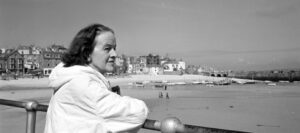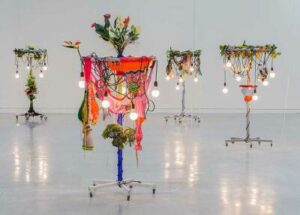
Haegue Yang: Creative Tensions

At Penlee House an interesting show explained the founding of the Penwith Society and included documents such as one where Ben Nicholson defends modern art as a new language. Also included were the controversial minutes of the Penwith Society when three categories of art were instituted: traditional, abstract and craft.
Centre stage as visitors entered was Marian Hocken’s The Hollow Men from 1955, which referred to her personal relationships within the artists’ community. Cruel remarks about this painting probably led to the artist becoming a recluse. In the picture are are three ‘joannie’ wooden figures above a view of St Ives, the grave of Alfred Wallis, and some tarot cards. It is telling a tale that is now obscure, but moving towards a simplified use of form.
I gleaned this long-lost scandal from the talk by Robin Lenman, who was inviting his audience to contribute their responses and brought in remarks from Will Gompertz’s book, Think Like An Artist. Having this knowledgeable person to inform and provoke really added to the experience.
Other works included a gentle, sweet and thoughtful drawing by Barbara Hepworth of two girls with teacups from 1949, the year the Penwith Society formed, breaking from the St Ives Society. The latter still survives and now shows a wider variety of art than the formerly more adventurous Penwith, now dominated by its past allegiance to non-figurative art.
The three Bryan Wynter paintings were outstanding, the 1957 Mineral World being a complex layered composition of structures and colours, while a Braque-influenced Patrick Heron presented a jigsaw puzzle of pink, green, blue and yellow with white outlines – a table in front of a window. Without Heron’s writing and American connections, it is doubtful whether the fame of these St Ives artists would have spread so far.
Terry Frost’s A Walk in the Snow, made during his time teaching in Leeds, needed its title to show us his way of thinking. By contrast, Wilhemina Barns-Graham apparently felt no need to hint at narrative in her powerful Lilac and Amber gouache from 1960.

Tony Shiel’s Four Frightened Bathers (1963) shows a move to the surreal and wild, using human forms (as he was said to oppose the ‘tasteful’ stuff’), that I feel was a helpful calm sanctuary from the horrors of WW2 and a way of recovering balance and sanity.
Unfortunately, it seems no book about the show and its important documentation of one of the major transformations in art history in the 20th century is to be made, but I hope enough is kept for future use and look forward to seeing the riches of the archive.
Mary Fletcher
Volume 34 no 3 January – February 2020 p 2
Creative Tensions: The Penwith Society of Artists 1949-1960 Penlee House, Penzance, UK, September 14 to November 16, 2019
The Penwith – A Society Like No Other – 1961 onwards
Penwith Gallery, St. Ives, UK, October 5 to November 2, 2019
Postscript to Mary Fletcher
I knew Marion Hocken and have many letters from her over several years’ of correspondence. Cornish-born, Marion was one of the founder members of the Penwith Society of Artists, but she was pushed aside by the modernist incomers. She told me that she painted The Hollow Men in one night to represent how she felt St Ives had sold its soul to tourism and the new wave of artists with their different mores. The painting takes its title from T.S.Eliot’s poem of the same name; its meaning is far from obscure. The death of the town is illustrated by numerous gravestones and memorials. A fishing trawler lies on its side on the harbour beach along with a dead fish. Trailing ivy winds its way through lobster pots, now put on gravestones in place of the Victorian glass bell jars. Alfred Wallis would turn in his grave. Three female Joannie dolls, also called Judas dolls because they were two-faced, take centre stage. These dolls were whittled by fishermen in the winter months. I believe the figure on the right is meant to be Barbara Hepworth. I hope to write a longer article on Marion next year.
year.
Victoria Howard
(We look forward to reading it. Ed.)

